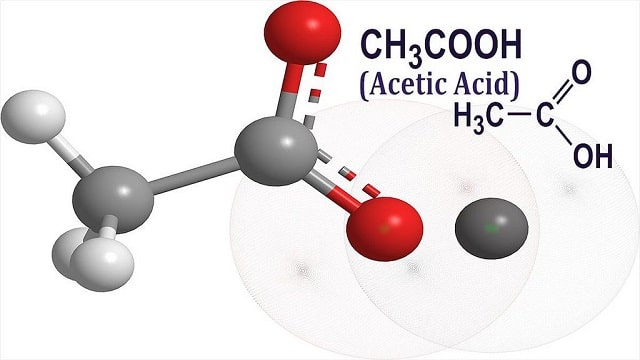Acetic Acid Meaning
The word acetic comes from the Latin “acetum”, which means “vinegar” (dilute acetic acid) and is used to refer to everything related to vinegar or that which originates it.
Acetic acid, methylcarboxylic acid or ethanoic acid; belonging to the carboxylic acids, is a weak acid, whose chemical formula is CH3-COOH (C2H4O2). It is an organic substance, produced industrially, in the presence of a catalyst by oxidation of acetaldehyde or when acetic bacteria act, fermenting the alcohol of wine in the presence of air. Its original synthesis was in 1847 and was due to the work of the German chemist, Hermann Kolbe, who obtained it from carbon disulfide. Pasteurization was achieved by Louis Pasteur, in 1895.
It has a pungent and penetrating odor, is colorless, flammable, soluble in water, and corrosive. It has a density of 1049 kg/m3 (g/cm3). Its melting point is 16.6 °C and its boiling point is 117.9 °C.
It has multiple applications, being used as a reagent or solvent, and to make acetates, paints, drugs, films, cleaners, and dyes, and to develop photographs. It is effective in eliminating micro-bacteria. Among other medical uses, it is useful as a dye in colposcopies, a study that serves to detect the human papilloma virus. Pure, it is very dangerous for the skin and must be handled with care. In this case, it is called glacial acetic acid. Diluted, like vinegar, it has various household uses, as a cleaner and disinfectant, and also in gastronomy, where it is commonly used as a seasoning and is recognized for its beneficial properties for health, such as reducing blood sugar, cholesterol, and blood pressure.
Acetic Acid Meaning in Hindi
एसिटिक शब्द लैटिन “एसिटम” से आया है, जिसका अर्थ है “सिरका” (पतला एसिटिक एसिड) और इसका उपयोग सिरका या उससे उत्पन्न होने वाली हर चीज को संदर्भित करने के लिए किया जाता है।
एसिटिक एसिड, मिथाइलकार्बोक्सिलिक एसिड या एथेनोइक एसिड; कार्बोक्जिलिक एसिड से संबंधित, एक कमजोर एसिड है, जिसका रासायनिक सूत्र CH3-COOH (C2H4O2) है। यह एक कार्बनिक पदार्थ है, जो औद्योगिक रूप से, एसीटैल्डिहाइड के ऑक्सीकरण द्वारा उत्प्रेरक की उपस्थिति में या जब एसिटिक बैक्टीरिया कार्य करते हैं, तो हवा की उपस्थिति में शराब के अल्कोहल को किण्वित करते हैं। इसका मूल संश्लेषण 1847 में हुआ था और यह जर्मन रसायनज्ञ, हरमन कोल्बे के काम के कारण था, जिन्होंने इसे कार्बन डाइसल्फ़ाइड से प्राप्त किया था। 1895 में लुई पाश्चर द्वारा पाश्चराइजेशन प्राप्त किया गया था।
इसकी तीखी और मर्मज्ञ गंध होती है, यह रंगहीन, ज्वलनशील, पानी में घुलनशील और संक्षारक होता है। इसका घनत्व 1049 kg/m3 (g/cm3) है। इसका गलनांक 16.6 °C है और इसका क्वथनांक 117.9 °C है।
इसके कई अनुप्रयोग हैं, इसका उपयोग अभिकर्मक या विलायक के रूप में किया जाता है, और एसीटेट, पेंट, ड्रग्स, फ़िल्म, क्लीनर और डाई बनाने और फ़ोटोग्राफ़ विकसित करने के लिए किया जाता है। यह सूक्ष्म जीवाणुओं को नष्ट करने में प्रभावी है। अन्य चिकित्सा उपयोगों के अलावा, यह कोलपोस्कोपी में डाई के रूप में उपयोगी है, एक अध्ययन जो मानव पेपिलोमा वायरस का पता लगाने के लिए कार्य करता है। शुद्ध रूप में, यह त्वचा के लिए बहुत खतरनाक है और इसे सावधानी से संभालना चाहिए। इस मामले में, इसे ग्लेशियल एसिटिक एसिड कहा जाता है। सिरके की तरह पतला करके, इसके कई घरेलू उपयोग हैं, क्लीनर और कीटाणुनाशक के रूप में, और गैस्ट्रोनॉमी में भी, जहाँ इसे आमतौर पर मसाले के रूप में उपयोग किया जाता है और स्वास्थ्य के लिए इसके लाभकारी गुणों के लिए पहचाना जाता है, जैसे कि रक्त शर्करा, कोलेस्ट्रॉल और रक्तचाप को कम करना।

